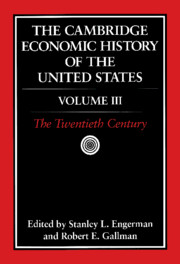Book contents
- Frontmatter
- 1 American Macroeconomic Growth in the Era of Knowledge-Based Progress: The Long-Run Perspective
- 2 Structural Changes: Regional and Urban
- 3 Twentieth-Century Canadian Economic History
- 4 The Twentieth-Century Record of Inequality and Poverty in the United States
- 5 The Great Depression
- 6 War and the American Economy in the Twentieth Century
- 7 U.S. Foreign Trade and Trade Policy in the Twentieth Century
- 8 U.S. Foreign Financial Relations in the Twentieth Century
- 9 Twentieth-Century American Population Growth
- 10 Labor Markets in the Twentieth Century
- 11 Labor Law
- 12 The Transformation of Northern Agriculture, 1910–1990
- 13 Banking and Finance in the Twentieth Century
- 14 Twentieth-Century Technological Change
- 15 The U.S. Corporate Economy in the Twentieth Century
- 16 Government Regulation of Business
- 17 The Public Sector
- Bibliographic Essays
- Index
- References
7 - U.S. Foreign Trade and Trade Policy in the Twentieth Century
Published online by Cambridge University Press: 28 March 2008
- Frontmatter
- 1 American Macroeconomic Growth in the Era of Knowledge-Based Progress: The Long-Run Perspective
- 2 Structural Changes: Regional and Urban
- 3 Twentieth-Century Canadian Economic History
- 4 The Twentieth-Century Record of Inequality and Poverty in the United States
- 5 The Great Depression
- 6 War and the American Economy in the Twentieth Century
- 7 U.S. Foreign Trade and Trade Policy in the Twentieth Century
- 8 U.S. Foreign Financial Relations in the Twentieth Century
- 9 Twentieth-Century American Population Growth
- 10 Labor Markets in the Twentieth Century
- 11 Labor Law
- 12 The Transformation of Northern Agriculture, 1910–1990
- 13 Banking and Finance in the Twentieth Century
- 14 Twentieth-Century Technological Change
- 15 The U.S. Corporate Economy in the Twentieth Century
- 16 Government Regulation of Business
- 17 The Public Sector
- Bibliographic Essays
- Index
- References
Summary
Public interest in America’s foreign trade has always concentrated on the issue of America’s “competitiveness” or “leadership” in foreign trade, and whether government policies have promoted it. This chapter addresses those perennial concerns. What has shaped America’s ability to compete, and her comparative advantage, in international trade? Has government policy toward foreign trade been aimed at raising national living standards, and has it had that result?
The five main conclusions reached here feature some rise-and-fall patterns and some revisions of frequent misconceptions:
1. America’s comparative advantages in natural-resource products and in skill-intensive products rose and fell in waves. Our relative exports of natural-resource products peaked around World War I, while our comparative advantage in skill-intensive products peaked in the 1950s and declined until the 1990s. In retrospect, one of the most striking features of American comparative advantage is the steady ascent of skill-intensive exports from the mid-nineteenth century to the mid-twentieth, whereas the “Dutch disease” model would have predicted that our abundance of natural resources would have killed our advantage in skill-intensive manufactures as in so many other countries.
2. U.S. competitive leadership rose and fell, peaking in the 1950s and hitting a low in the early 1980s before recovering somewhat. Early in this century it fell to British and Japanese writers to blame their business leaders, their workers, their government, and their national bad luck for the American, and German, competitive edge in the prestigious modern sectors. By the 1970s and 1980s America had caught up to Britain as a world leader in self-flagellation over lost markets.
3. ...
- Type
- Chapter
- Information
- The Cambridge Economic History of the United States , pp. 407 - 462Publisher: Cambridge University PressPrint publication year: 2000
References
- 2
- Cited by

